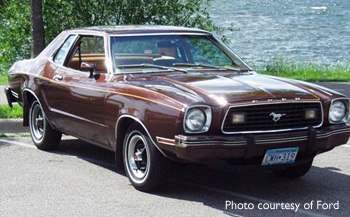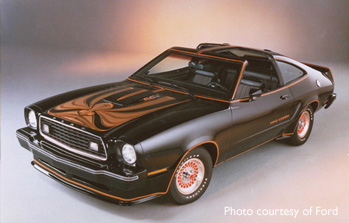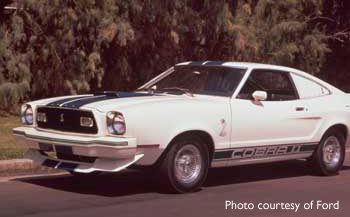Ford Mustang
SECOND GENERATION FORD MUSTANG: 1974 - 1978
Also called Ford Mustang II, the second generation Mustangs were produced from 1974 to 1978. Assembled at Dearborn Michigan, the body styles available for the second generation include 2-door coupes and 3-door hatchbacks. They were equipped with three types of engines, these being the 140 cu in I4, 171 cu in Cologne V6 and 302 cu in V8.
The 1973 Mustangs were much different from the 1964 model in terms of size. As such, hundreds of Mustang fanatics mailed Ford demanded that the next Mustangs returned to their original size and design. When Lee Iacocca took over presidency at the Ford Motor Company in 1970, he ordered the production of the smaller versions for the 1974 Mustang.
At the start of the 1974 production, the Mustangs were planned to be downsized based on the size of the compact Maverick, which was similar to the Falcon’s size and power, upon which the first Mustang has been based. However, due to the trend of smaller sporty coupes such as the Ford Capri and Toyota Celica made from Germany and Britain, Ford U.S. did not go through with their first plans. Instead, the company went in favor of a smaller Mustang, which they based from the subcompact Ford Pinto.
The original Mustang creator and Lee Iococca lead the Mustang II project. The new president believed that Ford has taken Mustang too far from its original concept, so the redesigning of the 1974 models was geared to make the vehicles back to their first design. Dubbed by Iococca as the “Little Jewel”, the Mustang II was based on the Ford Pinto.
The second generation Mustangs sold more than 400,000 units during its first year. The company had not seen such huge sales since the introduction of the original Mustang in April of 1964. Mustang II was equipped with innovations new to Ford, such as rack-and-pinion steering and separate engine sub-frames, which decreased vibration and noise dramatically.
Unfortunately, due to increasing insurance rates, Arab oil embargo and U.S. emissions & safety standards, the straight-line performance of cars produced in 1974 were destroyed.
 1974 Mustang
1974 Mustang
When the Mustang II was introduced in 1974, it became Motor Trend Magazine’s “Car of the Year”. Back to its roots, the second generation Mustangs returned the vehicle to the original 1964 model. Its shape, size and overall styling were based on the original Mustang design.
Ford president Iacocca insisted that the new Mustangs were “finished to quality standards never seen in the American automobile industry”. Although Iacocca predicted great outcome for the Mustang II, it suffered from being smaller to the original Mustang and heavier because it followed the new U.S. federal emission and safety regulations.
The Mustang II was equipped with superb engineering and handling features, but its performance still didn’t compare to other Ford products during its era. However, the second generation Mustangs competed directly to various sports car imports, such as the Datsun 2807 and Toyota Celica, which were being sold at the current market. Because of this, the Mustang II was downsized to adapt to fuel-efficient standards same to its competition.
The second generation Mustangs was available as a hardtop and as a 3-door hatchback. The engine was a 140 cu in SOHC 12, the first fully metric engine developed in the United States to be installed in an American vehicle. The only optional engine was the 171 cu in V6.
Packages for the Mustang II ranged from the base hardtops, 2_2 hatchbacks, the “Ghia” luxury group equipped with vinyl roof and a top-of-the-line V6-powered Mach 1. For the first and only time, Ford did not produce the popular V8 option with the Mustang II, except for Mexico units. As a result, Ford was bombarded with consumer mails and criticized widely by the automotive press for the company’s decision.
 1975 Mustang
1975 Mustang
Due to constant demand for the V8 engine, Ford re-engineered the 1975 model to include the 302 cu in V8 option again, but with 2-barrel carburetor and only 140 horsepower. With the installation of the V8 engine for the newest model, changes were need for the engine to fit. Such changes included the front fenders, header panel and engine bay. Since Ford Mexico did not lose the V8 option with the 1974 Mustang, they helped through the modifications.
By standards during the 1970’s, the Mustang II’s 302 engine performed quite well. It became the company’s first designated metric V8 Mustang. Since its capacity was 4.94 liters, it was called “5.0 L”. Aside from the changes made to reinstall the V8 engine, the 1975 Mustang underwent minor changes – “Ghia” was equipped with opera windows on its vinyl top. In addition, Ford offered an “MPG Stallion” option. Additional performance options were added to help boost sales and yield excitement to the automobile industry.
The name “5.0” would stay with Ford history until early 1990s, representing extraordinary performance power in a new generation of Mustangs.
1976 Mustang
In 1976, Ford introduced the Shelby-inspired Cobra II. Since racing was starting to become more and more popular during this era, the Cobra II was equipped with a non-functional hood scoop, front and rear spoilers, racing stripes available in white & blue or black & gold – all of which played to the racing desires of the public. Although the 1976 Mustang resembled the design and feel of the Shelby Mustang, however, it lacked the power of the original model.
 1978 Mustang
1978 Mustang
1978 saw the introduction of King Cobra. The King Cobra was a limited edition Mustang with only approximately 5,000 units manufactured. This limited edition Mustang featured a Pontiac Trans-Am styled cobra hood decal and had a deep air dam. However, it was only available with the V8 engine, which was used to increase the car’s performance. In 1977 and 1978, the Cobra II experienced a variety of styling changes and added several color options. When the Mustang II peaked its sales, a new Mustang model was later developed in 1979.